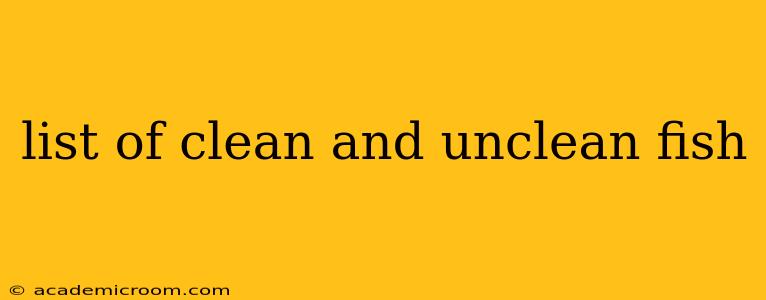The concept of "clean" and "unclean" fish originates primarily from the Old Testament book of Leviticus, specifically Leviticus 11:9-12. This distinction, however, is largely observed within specific religious contexts and isn't universally applied in modern dietary guidelines. This guide will explore the biblical definition and its implications, alongside a discussion of modern food safety concerns that extend beyond the religious classifications.
What Makes a Fish "Clean" According to Leviticus?
Leviticus 11 outlines the criteria for determining whether a fish is clean or unclean. The key factor is the presence of fins and scales. Specifically, the passage states that fish with both fins and scales are considered clean and fit for consumption. Those lacking either are deemed unclean and prohibited. This is a very specific biological classification, not based on taste, size, or any other characteristic.
What Types of Fish are Considered "Unclean"?
Fish classified as unclean according to Leviticus include those without both fins and scales. Examples of fish commonly considered unclean under this definition include:
- Eels: These elongated, serpentine fish lack scales.
- Catfish: While they possess fins, their skin is mostly scaleless.
- Shellfish (including crustaceans and mollusks): This broad category, encompassing shrimp, crabs, lobsters, clams, oysters, and more, explicitly falls under the unclean designation, lacking the required fins and scales.
- Hagfish and Lampreys: These eel-like creatures are often categorized as unclean due to their lack of scales and distinct anatomical differences from scaled fish.
Are There Health Concerns Beyond Religious Dietary Laws?
While the biblical distinctions between clean and unclean fish are based on religious observance, modern food safety and dietary considerations also play a crucial role in fish consumption. Factors like mercury levels, potential for contamination, and sustainability practices should guide consumers' choices irrespective of religious dietary restrictions.
Mercury Levels in Fish:
Some fish, particularly larger predatory species like tuna and swordfish, may contain higher levels of mercury. Excessive mercury intake can be harmful, particularly to pregnant women and young children. Choosing sustainably sourced and lower-mercury fish is a prudent choice.
Parasites and Bacteria:
Properly handling and cooking fish is essential to prevent the risk of parasitic infections or bacterial contamination. Undercooked fish can pose a significant health risk.
Sustainable Fishing Practices:
Overfishing is a serious threat to marine ecosystems. Consumers should choose fish from sustainably managed fisheries to help protect ocean biodiversity. Look for labels from reputable certification organizations.
Frequently Asked Questions
What is the difference between kosher and halal fish?
While both kosher (Jewish dietary laws) and halal (Islamic dietary laws) share similarities, there are subtle differences. Both generally follow the Levitical guidelines of fins and scales, but the specific methods of slaughtering and preparing the fish might vary slightly according to the respective religious practices.
Can I eat a fish that has scales but no fins?
According to Leviticus, no. The passage explicitly states that both fins and scales are necessary for a fish to be considered clean.
Is it safe to eat unclean fish?
The safety of eating fish classified as "unclean" depends on factors beyond the religious classification. Concerns about mercury levels, parasites, and bacteria should be addressed regardless of whether the fish is considered clean or unclean. Proper preparation and cooking are crucial for food safety.
This guide aims to provide a clear understanding of the concept of "clean" and "unclean" fish within its historical and religious context, while also emphasizing the modern considerations for safe and sustainable seafood consumption. Always prioritize reputable sources for information on food safety and dietary guidelines.
